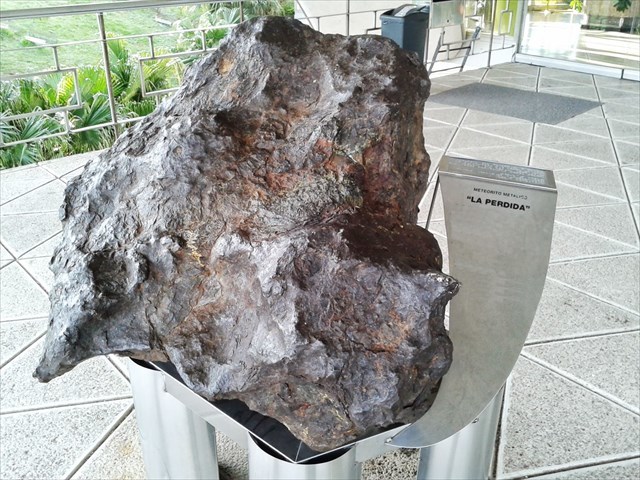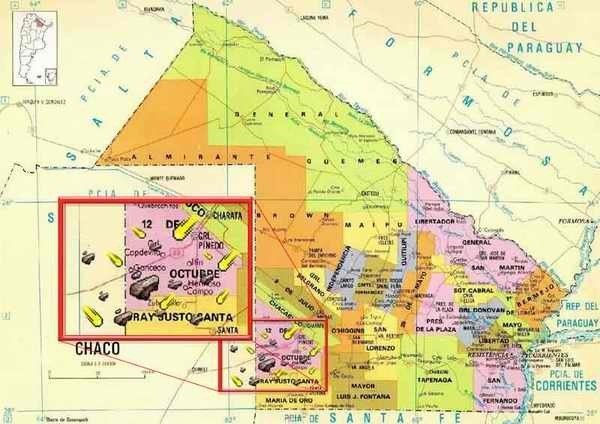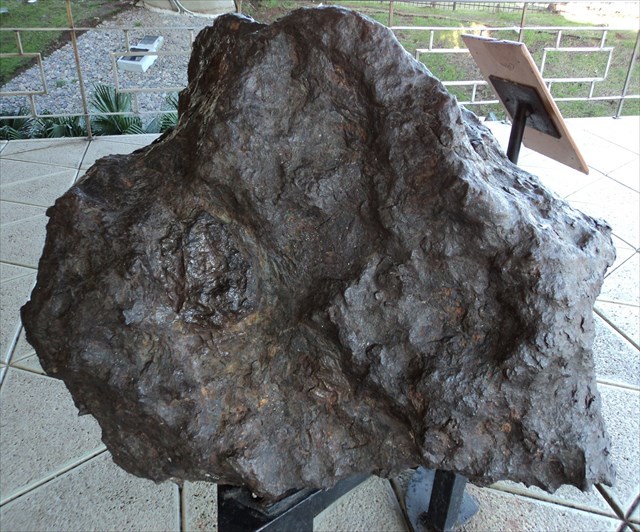El gran Meteorito Metálico "La Perdida", octaedrita IAB (composición hierro y níquel), con un peso de 1530 kg. Proviene de "Campo del Cielo", en las cercanías de la ciudad de Gancedo, provincia de Chaco, Argentina hallado en el año 1965.
The great Iron Meteorite "La Perdida (The Lost)", octaedrite IAB (composition iron and nickel), with a weight of 1530 kg. It comes from "Campo del Cielo (Field of the Sky)", near the city of Gancedo, province of Chaco, Argentina found in the year 1965.

La palabra meteoro significa "fenómeno del cielo" y describe la luz que se produce cuando un fragmento de materia extraterrestre entra a la atmósfera. Si el meteoro no se desintegra totalmente, cada fragmento que alcanza la superficie de la Tierra se llama meteorito, así llegaba, hace más de 4.000 años atrás.
No todos los Meteoritos son iguales, se clasifican en:
Férricos
Rocosos
Litosideritos
The word meteor means "sky phenomenon" and describes the light that is produced when a fragment of extraterrestrial matter enters the atmosphere. If the meteor does not completely disintegrate, every fragment that reaches the surface of the Earth is called meteorite, so it came, more than 4,000 years ago.
Not all meteorites are the same, they are classified in:
Iron Meteorites
Stone (stony) Meteorites
Stony-Iron Meteorites
Como ya mencionamos, "La Perdida", es un meteorito metálico que se caracteriza por estar compuesto mayoritariamente por hierro (Fe) y níquel (Ni), según el contenido de este último elemento, encontramos:
octaedritas (las más comunes)
hexaedritas (muy poco níquel)
ataxitas (mucho níquel)
Los meteoritos Campo del Cielo son del tipo meteorito metálico clasificados químicamente como octaedrita del grupo I AB. Se componen de hierro (92,9%), níquel (6,67%), cobalto (0,43%), fósforo (0,25%) y otros elementos como el galio (87 ppm), germanio (407 ppm) e iridio (3.6 ppm).
En la actualidad la tendencia oficial es la de mantener los meteoritos de "El Campo del Cielo" in situ o -en su defecto- transportarlos a las localidades más próximas a la zona en que se les ha hallado, en última instancia algunos bloques son llevados a estudiar y exponer en museos nacionales.
As we have already mentioned, "La Perdida", is a iron meteorite that is characterized by being mainly composed of iron (Fe) and nickel (Ni), according to the content of this last element, we find:
octahedrites (the most common)
hexahedrites (very little nickel)
ataxite (high nickel)
Campo del Cielo meteorites are of the metallic meteorite type chemically classified as octaedrite of group I AB. They are composed of iron (92.9%), nickel (6.67%), cobalt (0.43%), phosphorus (0.25%) and other elements such as gallium (87 ppm), germanium and iridium (3.6 ppm).
At present, the official tendency is to keep the meteorites of "El Campo del Cielo" in situ or, in their absence, to transport them to the localities closest to the area where they have been found, in the last instance some blocks are carried to study and exhibit in national museums.

Se han descubierto oficialmente 27 cráteres con sus correspondientes meteoritos, aunque se sospecha que algunos fueron saqueados y llevado fuera del país, y otros continúan enterrados en la maraña chaqueña a la espera de ser encontrados.
Cuando los meteoritos atraviesan la atmósfera de la Tierra a gran velocidad, su superficie se quema, formando lo que se conoce como costra o corteza de fusión. Esa fina capa de material fundido, generalmente es de color negro, gris o marrón oscuro, los signos de oxidación superficial se deben al tiempo que llevan expuestos.
Su aspecto de roca oscura muy compacta hace que se distingan perfectamente bien de su entorno.
El hierro en su forma metálica es extremadamente raro de forma natural en las rocas terrestres y sólo se encuentra en unos pocos yacimientos por todo el mundo. De esta forma, toda piedra metálica encontrada en este campo, se trata de un meteorito o de un fragmento del mismo.
27 craters with their corresponding meteorites have been officially discovered, although some are suspected to have been looted and taken out of the country, and others are still buried in the Chaco tangle waiting to be found.
When the meteorites cross the atmosphere of the Earth at great speed, its surface is burned, forming what is known as crust or melting crust. That thin layer of molten material, usually black, gray or dark brown, the signs of surface oxidation are due to the time they are exposed.
Its very compact dark rock aspect makes them perfectly distinct from their surroundings.
Iron in its metallic form is extremely rare naturally in terrestrial rocks and is only found in a few deposits all over the world.
In this way, any metallic stone found in this field, is a meteorite or a fragment thereof.

Requisitos de Registro:
1. Cuántos tipos de Meteoritos podemos encontrar en la Tierra?
2. Cuántos Meteoros podemos encontrar en el Planetario Galileo Galilei? Por qué?
3. El Meteorito "La Perdida", contiene restos de níquel?
4. El Planetario Galileo Galilei, alberga otros restos de "Campo del Cielo"?
5. Si nos trasladamos a "Campo del Cielo" y vemos una gran roca blanca que destaca por su gran tamaño, estamos frente a un Meteorito férrico?
6. Si te gusta tomar registros fotográficos de tus hallazgos, adjunta una foto del Meteorito y/o del Planetario.
Registration Requirements:
1. How many types of meteorites can we find on Earth?
2. How many Meteors can we find in the Galileo Galilei Planetarium? Why?
3. The Meteorite "La Perdida", contains remains of nickel?
4. The Galileo Galilei Planetarium, housing other remains of "Campo del Cielo"?
5. If we move to "Campo del Cielo" and see a large white rock that stands out for its large size, we are facing a iron meteorite?
6. If you like to take photographic records of your findings, attach a photo of the Meteorite and / or Planetarium.
It is not necessary to enter the Planetarium.
The Meteorites are outside.
Astronomical Square: free admission.

Bannercode:
<a href="https://coord.info/GC7BG0Q" target="_blank"><img src="https://img.geocaching.com/cache/large/fe7a933d-5e63-4bb9-93a0-ea87682f2e0a.png?rnd=0.5765846" alt="Meteorito La Perdida." title="Meteorito La Perdida."></a>